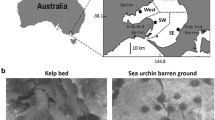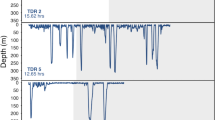Abstract
In highly seasonal intertidal habitats, changes in temperature through the year may drive substantial shifts in feeding and growth rates of organisms. For the dogwhelk Nucella lapillus, attacking and consuming Mytilus edulis mussels can take hours or days, depending on temperature. Handling time of dogwhelks feeding on mussels is therefore greatly affected by ocean temperature. I recorded attack time in the laboratory, partitioned into drilling and consumption time, for juvenile dogwhelks across a range of seawater temperatures representative of field seawater temperatures during the main growing seasons of summer and autumn. The combined length of a drilling attack and subsequent ingestion time tripled across the 10 °C decline in water temperatures from July through November, driven primarily by an increase in ingestion time. The observed reduction in handling time, coupled with projected sea surface warming in New England by the end of the twenty-first century, could extend the length of the growing season for Nucella and subsequently have cascading effects on the prey community.



Similar content being viewed by others
References
Audacity Development Team (2010) Audacity 1.3beta. http://audacity.sourceforge.net/
Bayne BL, Scullard C (1978) Rates of feeding by Thais (Nucella) lapillus (L.). J Exp Mar Biol Ecol 32:113–129
Brown KM, Stickle WB (2002) Physical constraints on the foraging ecology of a predatory snail. Mar Freshw Behav Physiol 35(3):157–166
Burrows MT, Hughes RN (1989) Natural foraging of the dogwhelk, Nucella lapillus (Linnaeus)—the weather and whether to feed. J Molluscan Stud 55(2):285–295
Burrows MT, Hughes RN (1990) Variation in growth and consumption among individuals and populations of dogwhelks, Nucella lapillus—a link between foraging behavior and fitness. J Anim Ecol 59(2):723–742
Burrows MT, Hughes RN (1991) Variation in foraging behavior among individuals and populations of dogwhelks, Nucella lapillus—natural constraints on energy intake. J Anim Ecol 60(2):497–514
Carriker MR (1981) Shell penetration and feeding by naticacean and muricacean predatory gastropods: a synthesis. Malacologia 20:403–422
Chétail M, Fournié J (1969) Shell-boring mechanism of the gastropod, Purpura (Thais) lapillus: a physiological demonstration of the role of carbonic anhydrase in the dissolution of CaCO3. Am Zool 9(3):983–990. doi:10.1093/icb/9.3.983
Connell JH (1961) Effects of competition, predation by Thais lapillus, and other factors on natural populations of the barnacle Balanus balanoides. Ecol Monogr 31(1):61–104
Denny MW, Hunt LJH, Miller LP, Harley CDG (2009) On the prediction of extreme ecological events. Ecol Monogr 79(3):397–421. doi:10.1890/08-0579.1
Etter RJ (1989) Life history variation in the intertidal snail Nucella lapillus across a wave-exposure gradient. Ecology 70(6):1857–1876
Fabry VJ, Seibel BA, Feely RA, Orr JC (2008) Impacts of ocean acidification on marine fauna and ecosystem processes. ICES J Mar Sci 65(3):414–432
Feare CJ (1970) Aspects of the ecology of an exposed shore population of dogwhelks Nucella lapillus (L.). Oecologia 5:1–18
Fisher JAD, Rhile EC, Liu H, Petraitis PS (2009) An intertidal snail shows a dramatic size increase over the past century. Proc Natl Acad Sci USA 106(13):5209–5212. doi:10.1073/pnas.0812137106
Fox J, Weisberg S (2011) An R companion to applied regression, 2nd edn. SAGE Publications, Thousand Oaks
Freeman AS, Byers JE (2006) Divergent induced responses to an invasive predator in marine mussel populations. Science 313:831–833
Gooding RA, Harley CDG, Tang E (2009) Elevated water temperature and carbon dioxide concentration increase the growth of a keystone echinoderm. Proc Natl Acad Sci USA 106(23):9316–9321. doi:10.1073/pnas.0811143106
Hughes RN, Drewett D (1985) A comparison of the foraging behavior of dogwhelks, Nucella lapillus (L.), feeding on barnacles or mussels on the shore. J Molluscan Stud 51(1):73–77
Hughes RN, Dunkin SB (1984) Behavioural components of prey selection by dogwhelks, Nucella lapillus (L.), feeding on mussels, Mytilus edulis L., in the laboratory. J Exp Mar Biol Ecol 77(1–2):45–68. doi:10.1016/0022-0981(84)90050-9
IPCC (2007) Climate change 2007: the physical science basis. Contribution of working group I to the fourth assessment report of the intergovernmental panel on climate change. In: Solomon S, Qin D, Manning M, Chen Z, Marquis M, Averyt KB, Tignor M, Miller HL (eds) Cambridge University Press, Cambridge
IPCC Working Group III (2000) IPCC Special report emissions scenarios. summary for policymakers. intergovernmental panel on climate change. 20 pgs
Jones SJ, Mieszkowska N, Wethey DS (2009) Linking thermal tolerances and biogeography: Mytilus edulis (L.) at its southern limit on the east coast of the United States. Biol Bull 217(1):73
Largen MJ (1967) The influence of water temperature upon the life of the dog-whelk Thais lapillus (Gastropoda: Prosobranchia). J Anim Ecol 36(1):207–214
Lemoine NP, Burkepile DE (2012) Temperature-induced mismatches between consumption and metabolism reduce consumer fitness. Ecology 93(11):2483–2489. doi:10.1890/12-0375.1
Matassa CM, Trussell GC (2011) Landscape of fear influences the relative importance of consumptive and nonconsumptive predator effects. Ecology 92(12):2258–2266. doi:10.1890/11-0424.1
Meehl GA, Covey C, Delworth TL, Latif M, McAvaney B, Mitchell JFB, Stouffer RJ, Taylor KE (2007) The WCRP CMIP3 multimodel dataset. Bull Am Meteorol Soc 88:1383–1394. doi:10.1175/BAMS-88-9-1383
Menge BA (1978) Predation intensity in a rocky intertidal community. Effect of an algal canopy, wave action, and desiccation on predator feeding rates. Oecologia 34(4):17–35
Palmer AR (1990) Effect of crab effluent and scent of damaged conspecifics on feeding, growth, and shell morphology of the Atlantic dogwhelk Nucella lapillus (L.). Hydrobiologia 193:155–182
Petraitis PS (1992) Effects of body size and water temperature on grazing rates of four intertidal gastropods. Aust J Ecology 17(4):409–414
Pincebourde S, Sanford E, Helmuth B (2008) Body temperature during low tide alters the feeding performance of a top intertidal predator. Limnol Oceanogr 53(4):1562–1573
R Development Core Team (2012) R: A language and environment for statistical computing. R Foundation for Statistical Computing, Vienna, Austria http://www.R-project.org/
Rall BC, Vucic-Pestic O, Ehnes RB, Emmerson M, Brose U (2010) Temperature, predator–prey interaction strength and population stability. Glob Change Biol 16(8):2145–2157. doi:10.1111/j.1365-2486.2009.02124.x
Rasband WS (1997-2013) ImageJ. US National Institutes of Health, Bethesda, Maryland http://rsb.info.nih.gov/ij/
Rovero F, Hughes RN, Chelazzi G (1999a) Effect of experience on predatory behaviour of dogwhelks. Anim Behav 57:1241–1249
Rovero F, Hughes RN, Chelazzi G (1999b) Automatic recording of the radular activity of dogwhelks (Nucella lapillus) drilling mussels (Mytilus edulis). J Mar Biol Assoc U K 79(6):1079–1083. doi:10.1017/S0025315499001320
Sandison EE (1967) Respiratory response to temperature and temperature tolerance of some intertidal gastropods. J Exp Mar Biol Ecol 1:271–281
Sanford E (2002a) The feeding, growth, and energetics of two rocky intertidal predators (Pisaster ochraceus and Nucella canaliculata) under water temperatures simulating episodic upwelling. J Exp Mar Biol Ecol 273:199–218. doi:10.1016/S0022-0981(02)00164-8
Sanford E (2002b) Water temperature, predation, and the neglected role of physiological rate effects in rocky intertidal communities. Integr Comp Biol 42:881–891
Stickle WB, Bayne BL (1987) Energetics of the muricid gastropod Thais (Nucella) lapillus (L.). J Exp Mar Biol Ecol 107(3):263–278. doi:10.1016/0022-0981(87)90043-8
Stickle WB, Moore MN, Bayne BL (1985) Effects of temperature, salinity and aerial exposure on predation and lysosomal stability of the dogwhelk Thais (Nucella) lapillus (L.). J Exp Mar Biol Ecol 93(3):235–258. doi:10.1016/0022-0981(85)90242-4
Trussell GC, Ewanchuk PJ, Matassa CM (2006a) Habitat effects on the relative importance of trait-and density-mediated indirect interactions. Ecol Lett 9(11):1245–1252
Trussell GC, Ewanchuk PJ, Matassa CM (2006b) The fear of being eaten reduces energy transfer in a simple food chain. Ecology 87(12):2979–2984
Vadas RL, Burrows MT, Hughes RN (1994) Foraging strategies of dogwhelks, Nucella lapillus (L.): interacting effects of age, diet and chemical cues to the threat of predation. Oecologia 100(4):439–450. doi:10.1007/bf00317866
Welch WR (1968) Changes in abundance of the green crab, Carcinus maenas (L.), in relation to recent temperature changes. Fish Bull 67(2):337–345
Widdows J, Bayne BL (1971) Temperature acclimation of Mytilus edulis with reference to its energy budget. J Mar Biol Assoc UK 51:827–843
Yamane L, Gilman SE (2009) Opposite responses by an intertidal predator to increasing aquatic and aerial temperatures. Mar Ecol Prog Ser 393:27–36. doi:10.3354/meps08276
Yee EH, Murray SN (2004) Effects of temperature on activity, food consumption rates, and gut passage times of seaweed-eating Tegula species (Trochidae) from California. Mar Biol 145:895–903. doi:10.1007/s00227-004-1379-6
Acknowledgments
The author was supported by a National Science Foundation grant OCE-0727628 to G. C. Trussell. C. M. Matassa collected the whelks and mussels, M. E. Bracken provided space for the monitoring equipment. C. A. Blanchette provided the original motivation for the project, and M. Jelenic provided thoughtful discussion on monitoring feeding behavior.
Author information
Authors and Affiliations
Corresponding author
Additional information
Communicated by M. G. Chapman.
Electronic supplementary material
Below is the link to the electronic supplementary material.
Rights and permissions
About this article
Cite this article
Miller, L.P. The effect of water temperature on drilling and ingestion rates of the dogwhelk Nucella lapillus feeding on Mytilus edulis mussels in the laboratory. Mar Biol 160, 1489–1496 (2013). https://doi.org/10.1007/s00227-013-2202-z
Received:
Accepted:
Published:
Issue Date:
DOI: https://doi.org/10.1007/s00227-013-2202-z




